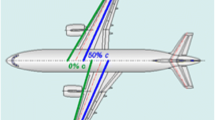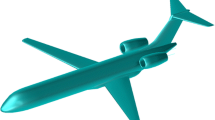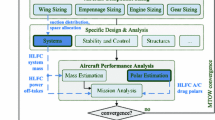Abstract
The objective of this paper is an enhanced analysis and assessment of a short-to-medium range aircraft configuration with natural laminar flow (NLF) and forward swept wings (FSW) designed by DLR. It is intended to show how the proposed aircraft concept could contribute to a more economic and ecologic operation. By implementing a multidisciplinary simulation and assessment framework, the net-benefit on air transportation system level is evaluated from airline perspective under consideration of realistic airline network conditions. Therefore operational aspects (e.g. stage length) and environmental factors (e.g. insect contamination, cloud encounter) which affect the aircraft effectiveness are included into the assessment. Apart from modeling the technology intended effect of fuel saving on airline economics, the study also aims to determine unintentional repercussions (e.g. change in maintenance effort, emissions, noise) which arise due to the design and the operation of the FSW–NLF concept. The overall goal of the paper is to provide aircraft operators with a better understanding of the behavior of NLF aircraft under realistic operational boundary conditions as well as to demonstrate resulting trade-offs between economical and ecological effectiveness.


















Similar content being viewed by others
Notes
Developed by Technische Universität Braunschweig.
Created by DLR Institute of Propulsion Technology.
Extension of NLF is essentially dependent on the pressure distribution and the local Reynolds number.
It should be noted that in real flight operations the change from laminar to fully turbulent flow under off-design conditions would be a continuous process and not as sudden as modeled in this study.
Developed by DLR Air Transportation Systems.
PANAM/SHADOW were developed by DLR Institute of Aerodynamics and Flow Technology.
More detailed analysis related to cleaning interval optimization and the economic effectiveness of the FSW–NLF aircraft can be found in [43].
Performed in the DLR project Climate Compatible Air Transportation System (CATS) [23].
References
Airbus: Getting hands-on experience with aerodynamic deterioration. Tech. Rep. STL 945.3399/96, Flight Operations Support and Line Assistance, Blagnac (2001)
Aircraft Commerce: Aircraft owners and operators guide: A320 family. Aircr. Commer. (44), 6-33 (2006)
Allison, E., Kroo, I., Sturzda, P., Suzuki, Y., Martins-Rivas, H.: Aircraft conceptual design with natural laminar flow. In: 27th International Congress of the Aeronautical Sciences (ICAS), Nice (2010)
Bertsch, L., Heinze, W., Lummer, M.: Application of an aircraft design-to-noise simulation process. In: 14th AIAA Aviation Technology, Integration, and Operations Conference (ATIO), AIAA 2014-2169. American Institute of Aeronautics and Astronautics, Atlanta (2014)
Bertsch, L., Isermann, U.: Noise prediction toolbox used by the DLR aircraft noise working group. In: Internoise Conference, Innsbruck (2013)
Bertsch, L.E.: Noise prediction within conceptual aircraft design. Forschungsbericht 2013–20, Deutsches Zentrum für Luft- und Raumfahrt e.V. (DLR), Braunschweig. Dissertation Technische Universität Braunschweig (2013)
Davis, R., Maddalon, D., Wagner, R.: Performance of laminar-flow leading-edge test articles in cloud encounters. In: Hefner, J., Sabo, F. (eds.) Reseach in Natural Laminar Flow and Laminar Flow-Control, vol. 1, pp. 163–194. National Aeronautics and Space Administration (NASA), Hampton (1987)
Davis, R., Maddalon, D., Wagner, R., Fisher, D., Young, R.: Evaluation of cloud detection instruments and performance of laminar-flow leading-edge test articles during nasa leading-edge flight-test program. Tech. Rep. NASA Technical Paper 2888, National Aeronautics and Space Administration (NASA) (1989)
Dijkstra, E.: A note on two problems in connexion with graphs. Numer. Math. 1(1), 269–271 (1959). doi:10.1007/BF01386390
Elsenaar, A., Haasnoot, H.: A survey on Schiphol airport of the contamination od wing leading edges of three different aircraft types under operating conditions. In: First European Forum on Laminar Flow Technology, pp. 256–261. Deutsche Gesellschaft für Luft- und Raumfahrt e.V. (DGLR), Bonn (1992)
Fisher, D., Fischer, M.: Development flight tests of JetStar LFC leading-edge flight test experiments. In: Hefner, J., Sabo, F. (eds.) Research in Natural Laminar Flow and Laminar-Flow Control, vol. 1, pp. 117–140. National Aeronautics and Space Administration (NASA), Hampton (1987)
Gratzer, L.: Evaluation of laminar flow control system concepts for subsonic commercial transport aircraft. Tech. Rep. NASA-CR-158976, Boeing Commercial Airplane Company (1978)
Green, J.E.: Laminar flow control—back to future? In: 38th Fluid Dynamics Conference and Exhibition, AIAA 2008-3738. American Institute of Aeronautics and Astronautics, Seattle (2008)
Grewe, V., Dahlmann, K.: Evaluating climate-chemistry response and mitigation options with AirClim. In: Schumann, U. (ed.) Atmospheric Physics, Research Topics in Aerospace, pp. 591–606. Springer, Berlin (2012)
Hansen, H.: Laminar flow technology—the airbus view. In: 27th International Conference of the Aeronautical Sciences (ICAS), Nice (2010)
Holmes, B., Obara, C.: Observations and implications of natural laminar flow on practical airplane surfaces. J. Aircr. 20(12), 993–1006 (1983)
Holmes, B., Obara, C.: Flight research on natural laminar flow applications. Natural laminar flow and laminar flow control. In: ICASE/NASA LaRC Series, pp. 73–142. Springer, New York (1992)
Horstmann, K., Streit, T.: Aerodynamic wing design for transport aircraft-today. In: Hermann Schlichting—100 Years, pp. 130–144. Springer, Berlin (2009)
Humphreys, B.: Surface contamination avoidance for laminar flow surfaces. In: First European Forum on Laminar Flow Technology, pp. 262–269. Deutsche Gesellschaft für Luft- und Raumfahrt e.V. (DGLR), Bonn (1992)
Humphreys, B., Totland, E.: Saab 2000 in-service test of porous surface HLFC. In: Aerodynamic Drag Reduction Technologies - Proceedings of the CEAS/DragNet European Drag Reduction Conference, pp. 89–98. Springer, Berlin (2001)
Jasperson, W., Nastrom, G., Davis, R., Holdeman, J.: GASP cloud- and particle-encounter statistics, and their application to LFC aircraft studies—volume I: Analysis and conclusions. Tech. Rep. NASA Technical Memorandum 85835, NASA (1984)
Joslin, R.D.: Overview of laminar flow control. Tech. Rep. NASA/TP-1998-208705, NASA (1998)
Koch, A.: Climate impact mitigation potential given by flight profile and aircraft optimization. Forschungsbericht 2013–37, Deutsches Zentrum für Luft- und Raumfahrt e.V. (DLR), Hamburg. Dissertation Technische Universität Hamburg-Harburg (2013)
Kruse, M., Wunderlich, T., Heinrich, L.: A conceptual study of a transonic NLF transport aircraft with forward swept wings. In: 30th AIAA Applied Aerodynamics Conference, AIAA 2012-3208. American Institute of Aeronautics and Astronautics, New Orleans (2012)
Langhans, S., Linke, F., Nolte, P., Schnieder, H.: System analysis for an intermediate stop operations concept on long range routes. J. Aircr. 50(1), 29–37 (2013)
Librescu, L., Khdeir, A.: Aeroelastic divergence of swept-forward composite wings including warping restraint effect. AIAA J. 26(11), 1373–1377 (1988)
Longmuir, M., Ahmed, N.: Commercial aircraft exterior cleaning optimization. J. Aircr. 46(1), 284–290 (2009)
Lufthansa Technik: Price list line maintenance services (German stations only) (2011)
Lührs, B., Linke, F., Gollnick, V.: Erweiterung eines Trajektorienrechners zur Nutzung meteorologischer Daten für die Optimimierung von Flugzeugtrajektorien. In: 63. Deutscher Luft- und Raumfahrtkongress 2014 (DLRK), Augsburg (2014)
Lummer, M.: Maggi–Rubinowicz diffraction correction for ray-tracing calculations of engine noise shielding. In: 14th AIAA/CEAS Aeroacoustics Conference (29th AIAA Aeroacoustics Conference), AIAA 2008-3050. American Institute of Aeronautics and Astronautics, Vancouver (2008)
Maddalon, D., Braslow, A.: Simulated-airline-service flight tests of laminar-flow control with perforated-surface suction system. Tech. Rep. NASA Technical Paper 2966, NASA (1990)
Maddalon, D., Wagner, R.: Operational considerations for laminar flow aircraft. In: Laminar Flow Aircraft Certification. NASA Conference Publication 2413, pp. 247–266. NASA, Langley Research Center Hampton (1986)
Meifarth, K.U., Heinrich, S.: The environment for aircraft with laminar flow technology within airline service. In: First European Forum on Laminar Flow Technology, pp. 251–255. Deutsche Gesellschaft für Luft- und Raumfahrt e.V. (DGLR), Bonn (1992)
Monner, H., Kintscher, M., Lorkowski, T., Storm, S.: Design of a smart droop nose as leading edge high lift system for transportation aircraft. In: 50th AIAA/ASME/ASCE/AHS/ASC Structures, Structural Dynamics, and Materials Conference, AIAA 2009-2128. American Institute of Aeronautics and Astronautics, Palm Springs (2009)
Pott-Pollenske, M., Wild, J., Bertsch, L.: Aerodynamic and acoustic design of silent leading edge devices. In: 20th AIAA/CEAS Aeroacoustics Conference, AIAA-2014-2076. American Institute of Aeronautics and Astronautics, Atlanta (2014)
Redeker, G., Wichmann, G.: Forward sweep—a favorable concept for a laminar flow wing. J. Aircr. 28(2), 97–103 (1991)
Rossow, C.: Aerodynamics—a discipline swept away? Aeronaut. J. 114(1160), 599–609 (2010)
Schwartz Dallara, E., Kroo, I., Waitz, I.: Metric for comparing lifetime average climate impact of aircraft. AIAA J. 49(8), 1600–1613 (2011)
Seitz, A., Kruse, M., Wunderlich, T., Bold, J., Heinrich, L.: The DLR project LamAiR: design of a NLF forward swept wing for short and medium range transport application. In: 29th AIAA Applied Aerodynamics Conference, AIAA 2011-3526. American Institute of Aeronautics and Astronautics, Honolulu (2011)
Weisshaar, T.A.: Aeroelastic tailoring of forward swept composite wings. J. Aircr. 18(8), 669–676 (1981)
Werner-Westphal, C., Heinze, W., Horst, P.: Multidisciplinary integrated preliminary design applied to unconventional aircraft configuration. J. Aircr. 45(2), 581–590 (2008)
Wicke, K., Kruse, M., Linke, F.: Mission and economic analysis of aircraft with natural laminar flow. In: 28th Congress of the International Council of the Aeronautical Sciences (ICAS), Brisbane (2012)
Wicke, K., Kruse, M., Linke, F., Gollnick, V.: Insect contamination impact on operational and economic effectiveness of natural-laminar-flow aircraft. J. Aircr. (2015). doi:10.2514/1.C033237
Wilson, R.: The introduction of laminar flow to the design and optimisation of transport aircraft. Ph.D. thesis, Cranfield College of Aeronautics, Cranfield (1997)
Wilson, R., Jones, R.: Project design studies on aircraft employing natural and assisted laminar flow technology. Tech. Rep. 952038, SAE Technical Paper Series, Cranfield University, Cranfield (1995)
Young, T., Humphreys, B.: Liquid anti-contamination systems for hybrid laminar flow control aircraft—a review of the critical issues and important experimental results. J. Aerosp. Eng. 218, 267–277 (2004)
Acknowledgments
The author would like to express his thanks to his colleagues Martin Kruse, Tobias Wunderlich, and Lothar Bertsch from the Institute of Aerodynamics and Flow Technology for their contributions and comments to this publication.
Author information
Authors and Affiliations
Corresponding author
Rights and permissions
About this article
Cite this article
Wicke, K., Gollnick, V. System analysis of aircraft with natural laminar flow and forward swept wings. CEAS Aeronaut J 7, 259–274 (2016). https://doi.org/10.1007/s13272-016-0187-2
Received:
Revised:
Accepted:
Published:
Issue Date:
DOI: https://doi.org/10.1007/s13272-016-0187-2




